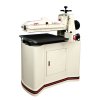- Joined
- Jul 1, 2013
- Messages
- 32,479
I have described the process of tacking down a sheet of sandpaper on a piece of tempered glass or marble to flatten out Scale sets for other new makers.
I've been at this a few years and I'm running out of elbow grease to get these scales nice & flat.
I've already had Carpel Tunnel & Cubical Tunnel "Elbow" surgery on one arm and am looking for recommendations for a Drum Sander that will get scales nice & flat in a few passes.
I'm currently looking at the, Grizzly G0716 - 10" Drum Sander.
Could others with experience with a drum sander or other tool/machine please share their brand of machine and any tips they may have on how to do this when they are already cut into book matched sets?
Thanks.
I've been at this a few years and I'm running out of elbow grease to get these scales nice & flat.
I've already had Carpel Tunnel & Cubical Tunnel "Elbow" surgery on one arm and am looking for recommendations for a Drum Sander that will get scales nice & flat in a few passes.
I'm currently looking at the, Grizzly G0716 - 10" Drum Sander.
Could others with experience with a drum sander or other tool/machine please share their brand of machine and any tips they may have on how to do this when they are already cut into book matched sets?
Thanks.

